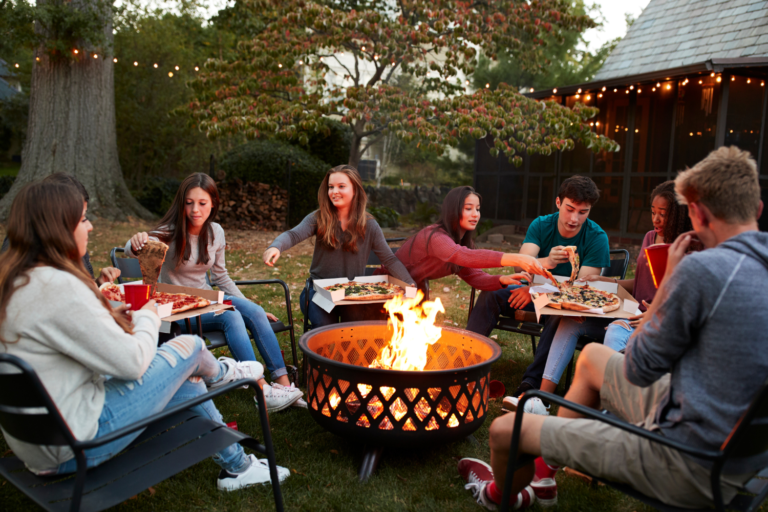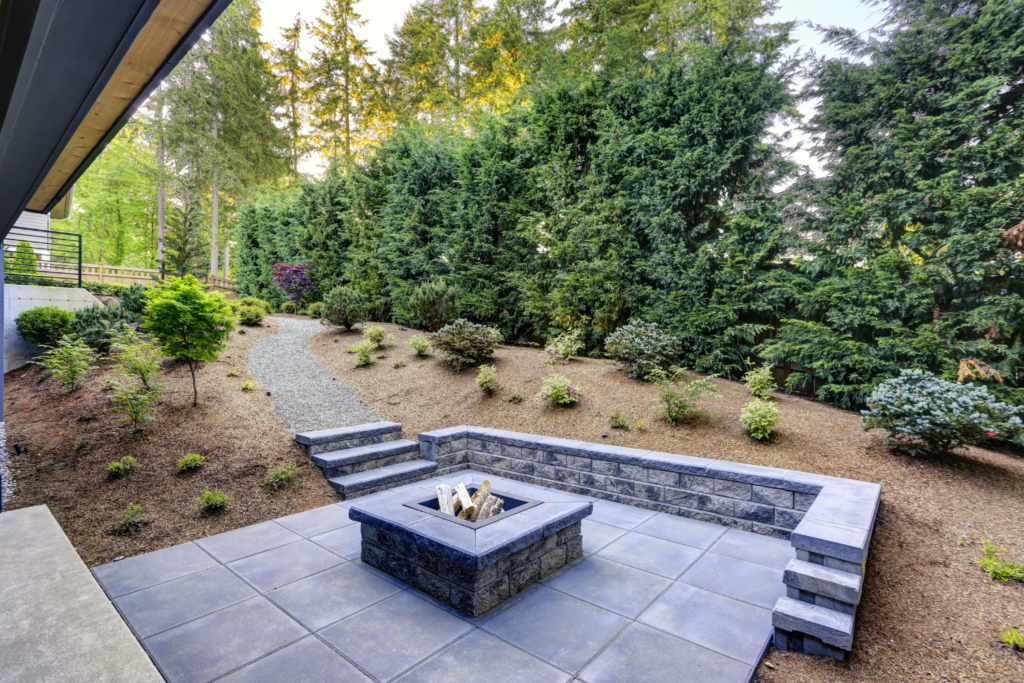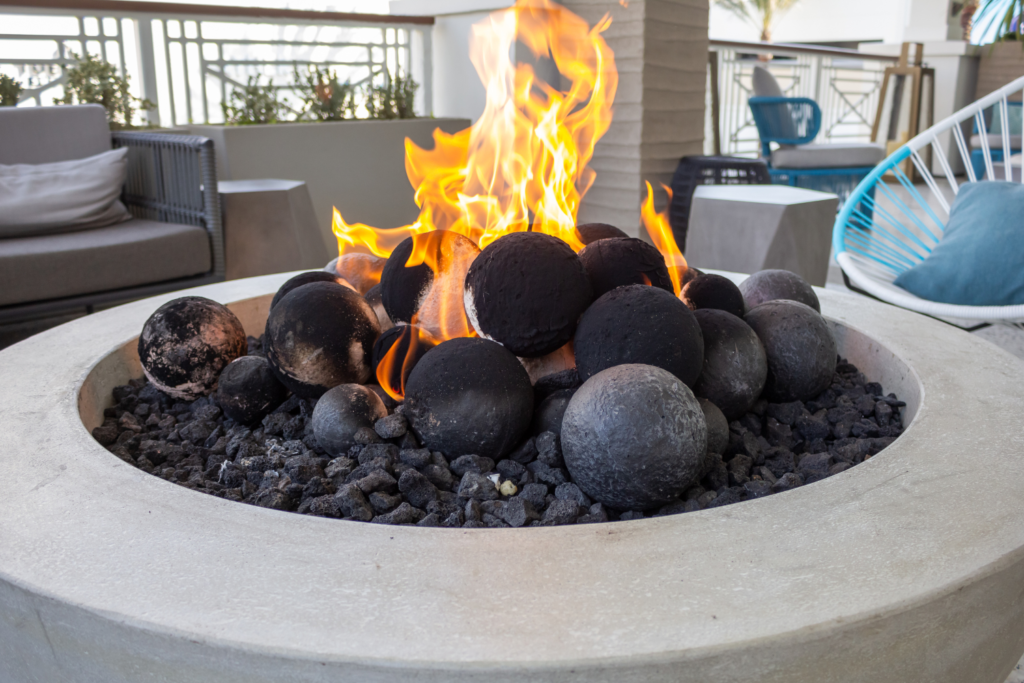
This post may contain affiliate links. As an affiliate, we earn from qualifying purchases. But we only recommend products we would use ourselves. View our Disclosure Policy here.
Fire pits are a quintessential feature of outdoor living spaces, offering warmth, ambiance, and a focal point for gatherings. When considering adding a fire pit to your backyard, the choice between gas and wood burning fire pits is pivotal. Each option comes with its own set of benefits, safety considerations, and design implications. In this article, we’ll delve into a detailed comparison of gas fire pits versus wood burning fire pits, covering various aspects such as functionality, safety, placement, design, and lighting.
Benefits of Gas Fire Pits:
- Convenience: Gas fire pits are exceptionally easy to ignite and control, typically operated with a simple push-button or remote control. They provide instant warmth without the hassle of gathering or chopping wood.
- Cleanliness: Gas fire pits produce minimal smoke, ash, or debris, resulting in a cleaner and more low-maintenance outdoor environment.
- Efficiency: Gas fire pits offer consistent heat output, allowing for extended use without the need for refueling or tending to the fire.
- Versatility: Gas fire pits come in a variety of designs and styles to suit different aesthetic preferences and outdoor spaces.
- Environmental Friendliness: Natural gas or propane options for gas fire pits are considered more environmentally friendly compared to burning wood, as they produce fewer emissions.
Benefits of Wood Burning Fire Pits:
- Authentic Ambiance: Wood burning fire pits evoke a rustic and cozy atmosphere, enhanced by the crackling sound and mesmerizing flames of a real wood fire.
- Cost-Effectiveness: Wood is often more affordable than gas, making wood burning fire pits a budget-friendly option in the long run.
- Versatility: Wood burning fire pits allow for cooking over an open flame, providing an additional function for outdoor gatherings.
- Customization: Wood burning fire pits offer the flexibility to adjust the size and intensity of the fire by adding more or less wood, giving users greater control over the ambiance and heat output.
- Sustainability: Using locally sourced firewood can be a sustainable option, supporting responsible forestry practices and reducing carbon emissions associated with transporting gas.
Safety Considerations:
- Regular maintenance of gas lines and components is essential to prevent leaks and ensure safe operation.
- Keep flammable materials away from the fire pit, and never store gas cylinders indoors.
- Install a heat-resistant barrier around the fire pit to prevent accidental contact.
- Educate users about proper handling of gas and emergency procedures in case of a gas leak or malfunction.
- Maintain a safe distance between the fire pit and any flammable structures or vegetation.
- Use a spark screen or cover to prevent embers from escaping and causing potential fires.
- Always extinguish the fire completely before leaving it unattended.
- Keep a fire extinguisher or water source nearby for emergencies.
- Consider local regulations and fire codes regarding open burning and wood fire usage.

Placement:
- Gas fire pits can be installed on various surfaces, including concrete, pavers, or decking, as long as proper ventilation is ensured.
- Consider proximity to gas lines and accessibility for maintenance when selecting the placement.
- Optimal placement allows for comfortable seating arrangements and unobstructed views of the flames.
- Choose a location away from overhanging trees, structures, or flammable materials to prevent accidental fires.
- Ensure adequate clearance from surrounding vegetation and combustible surfaces.
- Consider wind direction and prevailing breezes to minimize smoke exposure to seating areas.
Decor and Furniture:
- Select outdoor furniture that complements the style of the fire pit and enhances the overall ambiance of the space.
- Cozy seating options such as lounge chairs, benches, or built-in seating around the fire pit encourage relaxation and socialization.
- Incorporate weather-resistant cushions, throws, and rugs to add warmth and comfort to the outdoor seating area.
- Decorative elements such as lanterns, string lights, and potted plants can enhance the visual appeal of the space and create a welcoming atmosphere.
Safety Measures:
- Install adequate lighting around pathways, stairs, and seating areas to ensure safe navigation during evening gatherings.
- Use low-voltage LED lights or solar-powered fixtures for energy efficiency and durability.
- Consider motion-activated lights for added security and convenience.
Whether you opt for a gas fire pit or a wood burning fire pit, both options offer unique advantages and considerations. Gas fire pits provide convenience, cleanliness, and efficiency, while wood burning fire pits offer authenticity, cost-effectiveness, and versatility. Safety should always be a top priority when installing and using fire pits, regardless of the fuel type. With careful planning and consideration of design, safety, and placement, you can create a welcoming outdoor space that enhances your enjoyment and relaxation year-round.












